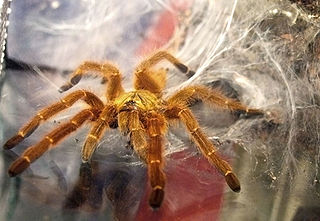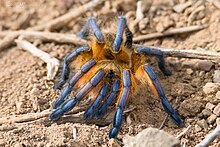
A tarantula hawk is a spider wasp (Pompilidae) that preys on tarantulas. Tarantula hawks belong to any of the many species in the genera Pepsis and Hemipepsis. They are one of the largest parasitoid wasps, using their sting to paralyze their prey before dragging it to a brood nest as living food; a single egg is laid on the prey, hatching to a larva which eats the still-living host. They are found on all continents other than Europe and Antarctica.

The Goliath birdeater belongs to the tarantula family Theraphosidae. Found in northern South America, it is the largest spider in the world by mass and body length, and second to the giant huntsman spider by leg span. It is also called the Goliath tarantula or Goliath bird-eating spider; the practice of calling theraphosids "bird-eating" derives from an early 18th-century copper engraving by Maria Sibylla Merian that shows one eating a hummingbird. Despite the spider's name, it rarely preys on birds.

Brachypelma is a genus of spiders in the family Theraphosidae (tarantulas). They may have bodies up to 6 cm long with legs of similar or greater lengths. Some species have brightly colored legs, with red or orange marks and rings.

One of the larger species of tarantula, the Chaco golden knee, formerly known as Grammostola aureostriata, can be expected to reach between 20 and 22 cm (8.5 in).

The Harpactirinae are a subfamily of tarantulas which are native to the continent of Africa. Like many Old World tarantulas, they have a relatively strong venom and can inflict a painful bite.

Pterinochilus murinus or the orange baboon tarantula, is an old-world tarantula that was first described in 1897 by Reginald Innes Pocock. This species is found on the African continent, in Angola, as well as central, eastern, and southern Africa. It is a member of the subfamily Harpactirinae, baboon spiders.

Tarantulas comprise a group of large and often hairy spiders of the family Theraphosidae. As of December 2023, 1,100 species have been identified, with 166 genera. The term "tarantula" is usually used to describe members of the family Theraphosidae, although many other members of the same infraorder (Mygalomorphae) are commonly referred to as "tarantulas" or "false tarantulas". Some of the more common species have become popular in the exotic pet trade. Many New World species kept as pets have setae known as urticating hairs that can cause irritation to the skin, and in extreme cases, cause damage to the eyes.
Hysterocrates gigas is a member of the tarantula family, Theraphosidae found in Cameroon. It is known as the giant baboon spider, Cameroon red baboon spider, or red baboon tarantula.

Heteroscodra maculata is an Old World species of tarantula which was first described in 1899 by Reginald Innes Pocock. This species native to West Africa and is found primarily in Togo and Ghana. This species has many common names, of which Togo starburst and ornamental baboon are most frequently encountered.

Hemipepsis ustulata is a species of tarantula hawk wasp native to the Southwestern United States. Tarantula hawks are a large, conspicuous family of long-legged wasps that prey on tarantulas. They use their long legs to grapple with their prey before paralyzing them with a powerful sting. Their stings are ranked as some of the most painful in the insect world according to the Schmidt sting pain index. They are solitary, displaying lekking territorial behavior in their mating rituals.

Ephebopus cyanognathus, known as the blue fang tarantula, is a species of tarantula. It is endemic to French Guiana. It was first described by Rick C. West and Samuel D Marshall in 2000, and is somewhat commonly kept as pets. As it common name may suggest, they have magnificent blue chelicerae, cyano meaning blue and gnathus meaning jaw. This tarantula is a burrowing spider, though spiderlings of this species have been observed to be semi-arboreal.

Encyocratella is a monotypic genus of Tanzanian tarantulas containing the single species, Encyocratella olivacea, also known as the Tanzanian black and olive baboon spider. It was first described by Embrik Strand in 1907, and is found in Tanzania.

Caribena laeta, otherwise known as the Puerto Rican pink toe tarantula, is a species of spider in the family Theraphosidae, found in the US Virgin Islands, Puerto Rico, and Cuba, the last dubiously according to Caroline Fukushima and Rogério Bertani in 2017. It was first described by Carl Ludwig Koch in 1842 under the name Mygale laeta.

Ceratogyrus marshalli, also known as Straight Horned Baboon or Great Horned Baboon Tarantula, is a species of tarantula from the genus Ceratogyrus. It is found in Zimbabwe and Mozambique. It was first described by Reginald Innes Pocock in 1897, as half of the Ceratogyrus genus, they own a impressive horn in the carapace.
Ornithoctonus aureotibialis is a tarantula species in the Ornithoctonus genus, it was first described by Volker von Wirth and Boris F. Striffler in 2005. It is named for the Latin, aureus being "golden" and tibia. Because of the gold or orange coloured line of hair in the tibiae of the legs in subadult and adult females and subadult males. Its common name is Thailand Golden Fringe, as the name may suggest it is found in Thailand, Myanmar and Malaysia. It is sometimes kept as a pet, and are captive bred.

Monocentropus balfouri is a tarantula in the Monocentropus genus, it was first described by Reginald Innes Pocock in 1897. This tarantula is also called Socotra Island Blue Baboon Tarantula, usually shortened to Blue Baboon Tarantula. This spider is named after its collector Isaac Bayley Balfour. It is found in Socotra Island, hence the common name. This tarantula is terrestrial and an opportunistic burrower. Like many tarantulas, M. balfouri can be kept as a pet, although it is not a beginner species.
Pterinochilus lugardi also known Grey starburst baboon, Dodoma baboon, Fort hall baboon or Tanzanian blonde baboon tarantula is a tarantula first described by Reginald Innes Pocock in 1900. They are found all over Southern and Eastern Africa, of course excluding Madagascar.
Eucratoscelus pachypus also known as the Tanzania stout leg baboon tarantula or the stout leg tarantula, was first described by Gunter Schmidt and Volker von Wirth in 1990. It is found in Tanzania, hailing from arid parts, and is an obligate burrower.

Harpactira cafreriana otherwise known as the Cape copper baboon or amber baboontarantula spider was first described by Charles Athanase Walckenaer in 1837. It is found in South Africa, being terrestrial or semi-fossorial in nature.
Heterothele gabonensis, also known as the Gabon blue dwarf baboon tarantula, is a species of tarantula found in Gabon. It was first described by Pierre Hippolyte Lucas in 1858, under the name Mygale gabonensis. They are semi arboreal tarantulas, that web quite a lot. They have also showed some communal tendencies in the form of tolerance for one another over an extended period of time.















